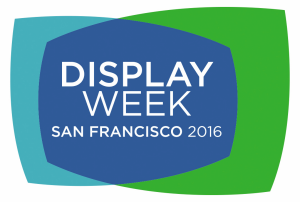
Phew! It’s been a busy week with the SID Display Week plus some admin issues – not quite the full Wannacry or BA IT disaster, but I had the joy of helping our IT specialist with some server issues via remote desktop from a hotel in LA! On the one hand, being able to access the network back at base is a great feature of the modern world. On the other hand, the time when you could focus 100% on the trip are long over!
We’ll have our full SID report next week, but there are already some clear highlights. BOE had an amazingly impressive display, given its limited number of years at the show and included a display that was built around electro-emissive quantum dots patterned, the company said, by inkjet printing. It looked like the hand-made sample that it was, but this is a technology that I didn’t expect to see for at least another two or three years. Emissive QDs, when production ready, should be bright, have great colour and high speed with wide viewing angles. Making them by inkjet printing should make them relatively cheap to make because of the lower level of investment needed. They are not expected to be suitable for smartphone applications as the maximum dot density is around 200 ppi to 300 ppi for inkjet printing, but they will be great for monitors and TVs. This could be the technology that really starts to attack LCD in its main application, if you look on an area basis.
Other highlights included incredibly flexible stainless steel films that could be used for OLED substrates. There were LCDs from JDI that use frame sequential technology and a new LC mode to eliminate polarisers and filters, to allow 80% transparency but showing images using edge lighting. These could see a lot of applications in retail and transport and, one day, be used in windows – especially in transport. ClearInk also showed the latest version of the electrophoretic technology showed last year. The performance of motion video on its monochrome display got a ‘Wow’ from me and its colour systems were impressive as well.
Flexible and rollable OLEDs were topics that came up all day at the Business Conference, and were everywhere on the show floor. Everybody is trying to get to commercialisation and there are still lots of issues to be solved from the point of view of the complete system, although the displays are now very, very good.
There was lots of buzz about microLED, of course, which is seen as one of the key display technologies for near-to-eye applications whether AR/VR or mixed reality. Really high dot densities of 700 to more than 2000 ppi were discussed and shown and there are new approaches to very wide gamut colour. Several times I heard comments about 90% of Rec 2020 as being some kind of special level for broadcasters, but I couldn’t find anyone that could tell me that there was some kind of standard or approval at that level. On the other hand, PixelDisplay, a start-up in the I Zone was showing tunable LEDs that can offer very highly selective LEDs that can get very close to 100% (97.8%) of Rec 2020. That’s very close to level achieved by lasers, but without the issues.
Also generating buzz was a comment by Jason Hartlove of Nanosys that it can see a path to creating QDs that could be electro emissive with >10% EQE – an order of magnitude better than current OLED materials.
This is an exciting time to be in the display business!
Bob

